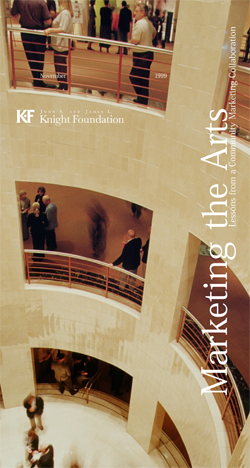Corporate Philanthropy
Corporate Philanthropy
Founded in 1947, the Los Angeles County Arts Commission is a unit of county government housed within the executive office of the county board of supervisors. Each of the five supervisors appoints three commissioners who advise the board on issues of governance, policy, and funding allocation. For fiscal year 2000-2001, the total budget of the Commission is approximately $3,815,000, reflecting a four-fold increase in only eight years. For this year, $1,902,000 has been awarded in grants to 146 organizations.
Read More..."Creativity takes time; it doesn't need time. Plants take time; they don't need time." In a panel discussion on artists at the ninth biennial DanceUSA Roundtable, Marda Kirn, former director of the Colorado Dance Festival, delivered a thoughtful, well-prepared presentation. The focus of her talk was artistic process — how we think about it and the language we use to describe it. Process has become mechanical, she said, as compared to something that is organic. “We tend to think about experimental labs as opposed to planting a garden. We say we need things — like time, space, money.
Read More...The so-called new economy, driven by an explosion in technological innovation and new communication tools, has especially affected California's San Francisco Bay Area, where web-based start-ups are overabundant and everything seems to be preceded by an "e". Perhaps because of their innovative nature, technology firms often locate offices in marginalized neighborhoods or abandoned industrial zones. At first this trend seemed to revitalize former nadirs of economic activity with new neighborhood restaurants, cafés, and other service-oriented businesses.
Read More...National Arts Stabilization (NAS) offered the first course in its executive education program in 1997. Originally called Strategic Leadership in a Changing Environment, Strategy is a three-day seminar that, according to the NAS website, provides arts leaders with "a framework for understanding how to:
- analyze the competitive environment,
- identify alternative strategies, and
- integrate mission and strategy."
The remarkable growth of the online sector in recent years can be assessed in many ways — from the rapidly expanding number of wired households (over half are now connected to the Internet) to the sheer explosion of content on the World Wide Web (which now encompasses over a billion pages). Data traffic exceeds voice traffic on the nation's phone lines now, and far more email messages than postal letters are sent every day.
Read More...In each issue of the Reader we intend to include at least one piece in the voice of an artist. Here we've chosen to reprint writer Irene Borger's interview with choreographer Joanna Haigood, from Force of Curiosity, Borger's interviews with past recipients of the CalArts/Alpert Award in the Arts. It is published here with Borger's permission.
Read More...2000 reprint edition, first published in 1992, 296 pages, paper. Arts Extension Service Press, University of Massachusetts, Amherst, ISBN 0-275-94054-3
Read More...Quarterly; nonprofit North American subscription rates vary according to budget size and the exchange rate ($104-$156); Henry Stewart Publications, Russell House, London, United Kingdom.
Read More...November 1999, 48 pages; John S. and James L. Knight Foundation, Miami, Florida.
Download:
Read More...1999, 23 pages. Final report of collaborative research project, Millennium Communications Group, Inc., 58 Salem Street, Andover, Massachusetts 01810.
Although its main focus seems to be on exploring ways of expanding philanthropy among new donors, Philanthropy's Current and New Stakeholders: Building a Common Vision for an Expanded Future also offers some interesting — and disturbing — observations on how traditional philanthropy is viewed.
Read More...
